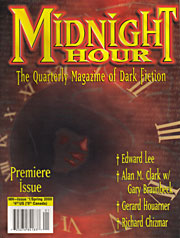 (Shadows in Stereo #1 aka NightSongs #4)
(Shadows in Stereo #1 aka NightSongs #4)
Originally Published in Midnight Hour
Spring 2000
I went down to St. James infirmary
To see my baby there
She was stretched out on a long white table
So pale, so cold, so fair
– Snakefarm, “St. James” (traditional)
Dead I am the one, exterminating son
Slipping through the trees, strangling the breeze
Dead I am the sky, watching angels cry
As they slowly turn, conquering the worm.
– Rob Zombie, “Dragula”
This is where your sanity gives in and love begins
never lose your gripdon’t trip, don’t fall
you’ll lose it all the sweetest way to die.
– Cardigans, “Paralyzed”
There’s a special space you want your head to slip into when sitting down to read or write horror.
It’s a murky space, a claustrophobic corridor rich in veiled mystery and threatening mayhem. But you can’t expect fiction spun of black ink of creamy paper to lock out and overcome your physical surroundings completely. You need to help set the mood. After all, how effective can simple words about the demons of the soul be if they’re read or written in the glaring sunshine of day with Ace of Base or Paula Abdul bounding gleefully in the background?
So then, this column is about setting the mood. About music that captures some of the same themes and nuance that your printed fiction might. It could be music that’s ambient or metallic or industrial…the linking chain for our purposes here is not its style but its effect. Other CDs will be reviewed in this magazine, some of which may have a connection to horror themes or not…but this column is strictly about what to turn on once the lights are turning off and the LEDs on the stereo gleam like warning signals through the shadows across the room.
Everybody has their favorite albums for certain mindsets. For nearly a year, every time I sat down to read or write horror and fantasy I put on Loreena McKennitt‘s 1994 album The Mask and Mirror — something in the anachronistic, otherworldly sounds of her harp, ethereal voice and accompanying ancient folk instruments moving atop throbbing complicated rhythms helped slide my head into that other place. Her 1997 followup, The Book of Secrets, also helped me to that “other space” quite a bit. Over the life of this column I’ll concentrate mainly on new releases, but will try to point out some great older treasures like The Mask and Mirror as well.
Digging In
I should probably admit right out that I’m no fan of country and folk music. Despite this, Snakefarm‘s Songs From My Funeral on RCA Records tops my first quarter 1999 list of favorite releases. Snakefarm is the duo of vocalist Anna Domino and guitarist/programmer husband Michel Delory and their debut release takes 10 traditional folk songs about death and murder, lays them atop throbbing and ambient grooves and completely reconstructs them to fit a modern muse. The twang is replaced by echoing guitar strums and mysterious keyboard sighs.
should probably admit right out that I’m no fan of country and folk music. Despite this, Snakefarm‘s Songs From My Funeral on RCA Records tops my first quarter 1999 list of favorite releases. Snakefarm is the duo of vocalist Anna Domino and guitarist/programmer husband Michel Delory and their debut release takes 10 traditional folk songs about death and murder, lays them atop throbbing and ambient grooves and completely reconstructs them to fit a modern muse. The twang is replaced by echoing guitar strums and mysterious keyboard sighs.
Listen close and you’re bound to recognize many of these from childhood; who hasn’t heard “Tom Dooley” or the 1800s railroad ballad “John Henry”? But Snakefarm takes brave and darkly beautiful liberties with these classics — “campfire songs” is not what you’ll be thinking as you listen to this CD, despite the fact that folky campfire singalongs is where you were most likely to have heard them before. Domino’s voice has that quietly powerful flavor that made Cowboy Junkies so successful, and her reading of these songs will leave you thinking things like spooky, haunting and strangely moving.
“This Train That I Ride,” with its background vocal tension, open synthesizer bass groove and sci-fi sonic wash of warmth and repetition stands ahead of anything Madonna and William Orbit managed on Ray of Light for airy techno brilliance. And if the words weren’t so familiar, you’d probably never even place the classic “(House of the) Rising Sun,” which, instead of being pumped up with the rock force of The Animals’ famous version, prefers to stick with a somber recitation of the lyrics over an appropriately dirgelike rhythm and splashes of Western wah-wah guitars. It’s a coolly disturbing take.It’s amazing, really, to look at the genesis of these songs, and then to hear how immediate and modern Snakefarm makes them. There’s no feeling at all that these are dusty, cautionary folk ballads. Yet “Pretty Horses” (now built on a sinister groove) was a lullaby sung to a master’s child by a slave who must leave her own child to cry alone, “Rising Sun” is an 18th century bordello lament, “Tom Dooley” is about the hanging of a murderer in 1868 and “This Train That I Ride,” one of the discs most eerily groovin’ rewrites, is about the early conquering of the American frontier.
Songs From My Funeral acts as both a tribute to America’s past and an ethereally danceable new work of art to live on in its future. It also makes for a great mental portal to another place.
S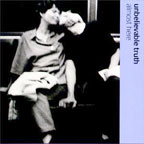 ongs has been alternating in my CD drive with another disc that was released and widely ignored at the turn of the year. Unbelievable Truth‘s Almost Here on Virgin Records opens with a quietly reverberating guitar lattice and builds to a moving mix of melancholic pop that’s ultimately hard to resist. This is a quietly haunting album spotlighting the charismatically smooth vocals and lusciously bittersweet songs of singer-guitarist Andy Yorke, brother of Radiohead leader Thom Yorke.
ongs has been alternating in my CD drive with another disc that was released and widely ignored at the turn of the year. Unbelievable Truth‘s Almost Here on Virgin Records opens with a quietly reverberating guitar lattice and builds to a moving mix of melancholic pop that’s ultimately hard to resist. This is a quietly haunting album spotlighting the charismatically smooth vocals and lusciously bittersweet songs of singer-guitarist Andy Yorke, brother of Radiohead leader Thom Yorke.
Almost Here is an insidious album — on a first listen, it’s melodic background stuff: slowly strumming guitars, rising keyboard auras, rolling basslines. But with every subsequent visit, Yorke’s gently delivered leads and warm harmonies get under the skin deeper and deeper, each plaintive viola and cello strain a knot around your soul. His near-whispered delivery on “Angel” listens like an incense-soaked prayer but with an inherent finality that says the prayer’s desire will never be requited. Like early Toad The Wet Sprocket, this is the music of black and white photos, filled with regret and longing — atmospheric pop with ironclad hooks. Highly recommended.
N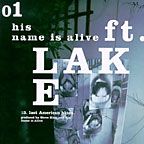 ow you might think that the same description could cover the latest disc from 4AD’s His Name Is Alive. The band which evoked cemeteries and cathedrals with its mix of dirge and drama on Livonia and Home is In Your Head in the early ‘90s has evolved quite a bit from those beginnings, however. HNIA has always had a floating lineup of players, but their latest, Ft. Lake, includes only leader Warren Defever and vocalist Karin Oliver left over from its early ‘90s lineups. At one point in the early days of the decade, Defever was pulling off a rare feat — two bands on two different labels, his This Mortal Coil-esque atmospheric home studio collaborative in HNIA for 4AD, and a hellbilly outfit called Elvis Hitler on Restless (Elvis Hitler’s 1992 album Supersadomasochisticexpialidocious, by the way, makes for some humorously abrasive horror listening if you can find it. Liquor and violence-steeped titles include “Bloody Bride,” “Ghoul,” “Bury The Hatchet (right in your skull)” and a twisted metallic take on The Ohio Express’ “Yummy Yummy Yummy.” You’ll never listen to the cotton candy version in the same way again.)
ow you might think that the same description could cover the latest disc from 4AD’s His Name Is Alive. The band which evoked cemeteries and cathedrals with its mix of dirge and drama on Livonia and Home is In Your Head in the early ‘90s has evolved quite a bit from those beginnings, however. HNIA has always had a floating lineup of players, but their latest, Ft. Lake, includes only leader Warren Defever and vocalist Karin Oliver left over from its early ‘90s lineups. At one point in the early days of the decade, Defever was pulling off a rare feat — two bands on two different labels, his This Mortal Coil-esque atmospheric home studio collaborative in HNIA for 4AD, and a hellbilly outfit called Elvis Hitler on Restless (Elvis Hitler’s 1992 album Supersadomasochisticexpialidocious, by the way, makes for some humorously abrasive horror listening if you can find it. Liquor and violence-steeped titles include “Bloody Bride,” “Ghoul,” “Bury The Hatchet (right in your skull)” and a twisted metallic take on The Ohio Express’ “Yummy Yummy Yummy.” You’ll never listen to the cotton candy version in the same way again.)
Well, it’s been years since anyone’s heard of Elvis Hitler, but HNIA has released a string of often ethereal singles, EPs, mail order specials, collections and even the occasional 4AD regular studio album throughout the ‘90s. Defever’s approach on Ft. Lake is much less ambient than his Cocteau Twins/Dead Can Dance-influenced moody early days. While still decidedly experimental and offbeat, the songs on Ft. Lake roll in touches of urban soul (“No Hiding Place Down Her,”) Wendy & Lisa-sounding pop-funk (“Wishing Ring,” “Up Your Legs Forever”), carnival-candy rock (“Red Haired Girl”) and retro-electronicism a la early Depeche Mode or Yaz (“Don’t Glue The World, ” “The Waitress”).
There are crunchy guitar riffs that make “Everything Takes Forever” almost danceable and “The Waitress” almost straightforward enough to be a rock radio read single; heck there’s even a guitar solo (gasp). And the handclaps and pounding electric piano of “Can’t Always Be Loved” reek of late ‘60s pop sense.
This is definitely an upbeat album for HNIA, but its avant atmosphere fans shouldn’t fear: Ft. Lake is still peopled with the long-running project’s requisite mood shifts, bizarre musical seques, vocalist trade-offs and tongue-out-at-conventions sense of independent style.Speaking of tongues out at conventions…
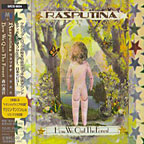 Rasputina has managed to break just about every rule there is binding a good girl with a cello. How We Quit The Forest, released last fall on Columbia, is one of the strangest records you are ever likely to hear. It was also on my list of the top discs of 1998 for its brash inventiveness.
Rasputina has managed to break just about every rule there is binding a good girl with a cello. How We Quit The Forest, released last fall on Columbia, is one of the strangest records you are ever likely to hear. It was also on my list of the top discs of 1998 for its brash inventiveness.
Rasputina is a three-woman group of cellists with a dark alternative rock side and a quirky sense of humor. This is not a “nice” gentle orchestral outfit — on their last album, Marilyn Manson stepped in to remix one of their “creepier” tracks — “Transylvanian Concubine” — with crypt-ish vocal effects and abrasive guitars. This is great music to put your head on another plane, because it really sounds like the band is hailing from…well…way elsewhere. Vocalist-songwriter Melora Creager sings with a weirdly pronounced tremolo that echoes the quaver of her cello. The effect is sometimes creepy and always ethereal and moody, and the subjects that she writes about don’t belay that — song titles include the medieval sounding “The Olde Headboard” and “Leechwife” and there’s a beautifully strange cover of ‘60s pop star Lesley Gore’s “You Don’t Own Me.”
There’s also a song (spoken with gleeful matter-of-fact drama over the hymn “Christian Soldiers”) about medieval exorcists and what they did with a 20-gallon brass syringe of holy water that belongs in a horror movie somehow. After demonstrating how Rasputina grinds out distortion riffs, shoots them down with momentary shifts to classical and then slips into disturbingly odd humor for a friend, I mentioned I would probably go home and listen to it as I went to sleep that night . His mouth gaped in awe — “Won’t it give you nightmares?” he asked.
N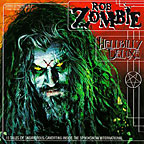 ow listening to Rob Zombie‘s first post-White Zombie solo disc Hellbilly Deluxe on Geffen, I could understand having a dark dream or two.Deluxe opens with a child reading a hellish zombie nursery rhyme over a backdrop of thunder and clock ticking. That’s the only bit of slow creepy mood you’re going to find on this disc though. This is a CD that rarely ever gets out of in-your-face, over-the-guard-rail overdrive. Zombie growls and gargles his hell-on-speed lyrics over a bed of car crash crunching guitars and pounding industrial rhythms. The first track, “Superbeast” is a catchy metallic slam fest that threatens of the pursuits of the undead — “the ragged they come and the ragged they kill,” flails Zombie as the guitars chug heroically ahead.
ow listening to Rob Zombie‘s first post-White Zombie solo disc Hellbilly Deluxe on Geffen, I could understand having a dark dream or two.Deluxe opens with a child reading a hellish zombie nursery rhyme over a backdrop of thunder and clock ticking. That’s the only bit of slow creepy mood you’re going to find on this disc though. This is a CD that rarely ever gets out of in-your-face, over-the-guard-rail overdrive. Zombie growls and gargles his hell-on-speed lyrics over a bed of car crash crunching guitars and pounding industrial rhythms. The first track, “Superbeast” is a catchy metallic slam fest that threatens of the pursuits of the undead — “the ragged they come and the ragged they kill,” flails Zombie as the guitars chug heroically ahead.
In “Dragula,” the disc’s first single, he yells over the chug of industrial guitars about a midnight ride: “dig through the ditches, burn through the witches/I slam in the back of my dragula.” Probably the most intriguing track here is “Living Dead Girl,” which features an Indian interlude, clips of a girl whispering “what are you thinking about” and a pounding chorus about the decadent pursuits of the title zombie. Hellbilly Deluxe is the high octane soundtrack of “Creature Features” of the ‘90s. This is also the best mix of hard rock and roll and nightmare theme that I’ve heard.
If you’ve caught Zombie on tour lately, you’ve probably seen Videodrone opening up for him. I don’t know how they come across live, but the band’s self-titled debut LP just came out on Elementree/Reprise and probably would have been better off as an EP. It leads off promisingly enough with “Ty Jonathan Down,” an edgey, eerie bit of noise that borrows equally from the NIN and Marilyn Manson camps as the band wails and moans the hook: “Some things are better left unsaid/some things are better forgotten.”
There are a handful of other good exercises in sound effects rock and mood that work, including the tape loop-infested “Closer to Coma,” but then the band trades in its steely threatening atmosphere for unoriginal alt-rock stomp riffs with a touch of rap-dance and you’ve just gotta turn it off. It’s as if a different band with the same sound effects jones steps in as musical stunt doubles to record tracks 7-12. If you do make it to the end of the CD, you’ll find a warped version of “Silent Night,” but I wouldn’t try too hard to get to it. The first half of the disc, with its shifting kaleidoscopes of threatening half-whispered vocals, metallic guitars (a la the sound of Zombie’s “Dragula”) and futuristic synthesizer bleeps is worth programming in on your multi-CD player, though.
You’d expect a soundtrack to a movie dealing with high school horror to have some good creepy moments to it, but I’m here to warn you — the soundtrack for The Faculty on Columbia is more of a nostalgia update fest than a mood setter.Bookended by a throbbing, oatmeal-mouthed workout of the two parts of Pink Floyd’s “Another Brick In The Wall” by grunge kings Layne Staley (Alice in Chains) and Tom Morello (Rage Against The Machine) under the moniker Class of ‘99, the real draw is in the other yesteryear “teen” rock anthems covered by today’s artists. Creed drawl through Alice Cooper’s “I’m Eighteen” and Soul Asylum offer a great big guitar revisitation to Cooper’s classic “School’s Out.” And Shawn “Lullaby” Mullins turns to David Bowie’s “Changes” (which was recorded with Eric Bazilian of The Hooters, for all you trivia fans).
There are also songs taken from the most recent Offspring, Stabbing Westward and Garbage albums. No real mood setters here.
A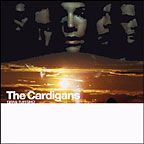 nd then came The Cardigans… I didn’t expect to ever feature a Cardigans album in this column. But the band’s latest, Gran Turismo on Mercury, leads off with a distinctly dark tone, one that carries through the entire album. The Cardigans still can’t help but lapse occasionally into that cutesy, kitschy ‘60s pop-lounge zone that made their “sound” distinctively famous, thanks to Nina Persson’s waifishly angelic vocals and their retro guitars, but this is a definitely moodier album than their past couple of releases. A reaction against the bubblegum hit “Lovefool” from the Romeo and Juliet soundtrack? Perhaps. You can’t smile and put a finger in your cheek dimple every hour of every day for two years of touring without some backlash.
nd then came The Cardigans… I didn’t expect to ever feature a Cardigans album in this column. But the band’s latest, Gran Turismo on Mercury, leads off with a distinctly dark tone, one that carries through the entire album. The Cardigans still can’t help but lapse occasionally into that cutesy, kitschy ‘60s pop-lounge zone that made their “sound” distinctively famous, thanks to Nina Persson’s waifishly angelic vocals and their retro guitars, but this is a definitely moodier album than their past couple of releases. A reaction against the bubblegum hit “Lovefool” from the Romeo and Juliet soundtrack? Perhaps. You can’t smile and put a finger in your cheek dimple every hour of every day for two years of touring without some backlash.
But actually, there has always been a touch of gloom behind Persson’s deceptively happy tones, and this album simply lets her go with it, letting her languidly stretch and soar. This time out, she rails in sirenlike cries against the “Junk of the Hearts” and scoffs at the idea that “love will save the world.’Radio has picked up on the peppy crunch and croon of “My Favourite Game,” one the album’s most upbeat tracks, but even it has a negative vibe — “my heart is black/and my body is blue,” she sings.
Longtime fans will notice that the band modernizes its sound somewhat on this disc with more electronic keyboards than usual, adding to the often dark ambience of Gran Turismo. But The Cardigans still are recorded with a live lounge band feel, and whether they’re rocking out on “My Favourite Game” or stretching sinuously with a funky backbeat on “Do You Believe,” the band remains true to its Janus-like musical vision and bittersweet heart.
Grave Robbing:
O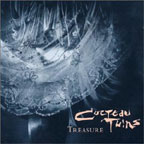 K, I promised to spotlight at least one disc in each column that’s worth a couple trips to the used CD outlets to unearth. As far as I’m concerned, anybody who ever daydreams should own a copy of the Cocteau Twins’ Treasure CD from 1984 on 4AD Records.
K, I promised to spotlight at least one disc in each column that’s worth a couple trips to the used CD outlets to unearth. As far as I’m concerned, anybody who ever daydreams should own a copy of the Cocteau Twins’ Treasure CD from 1984 on 4AD Records.
There are very few albums I’ve heard before or since that so perfectly capture a glimpse of something…other. With heavily chorused walls of feather-stroked guitars, a throbbing rhythm churn, chiming haunted bells and singer Elizabeth Fraser’s sudden yelps and sensually whispered alien pronunciations of supposedly English syllables (I couldn’t tell you what a single one of these songs is about and I’ve listened to the disc for 15 years!) Treasure listens like a haunted aural postcard from the beyond. At times Fraser’s chanting dual vocals and melodic leaps sound angelic. And at others, when the enhanced drum crashes snap menacingly, and the wash of sound strikes fire beneath her pirouettes, it may be the soundtrack to a daring escape from the fires below.
The breathtaking rests and subsequent explosions of glorious sound on the final track, “Donimo” could be recounting that nail-biting last dash to the exit of the gates of hell, or alternately, perhaps some coronation amidst the Furies. The ghostly album artwork and mythical song titles (“Ivo,” “Lorelei,” “Beatrix,” “Persephone,” “Pandora,” etc.) extend the feeling that the band was channeling well back in 1984 — this disc feels like a recording from realms that only live in fable. Treasure is just what it’s labeled; an indescribably rich piece of solemn, strange beauty. It’s as thrilling and haunting to hear today as it was in the mid-’80s.
If you don’t own it, try to find it before it fades away.





